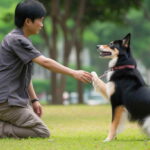
Companionship Dog Training
PETSIDI – Hey there, fellow dog enthusiasts! Today, let’s delve into the wonderful world of companionship dog training. If you’re like me, your four-legged friend isn’t just a pet; they’re a cherished companion. Companionship dog training is all about nurturing that special bond between you and your pup while enjoying the benefits of a well-behaved and happy furry friend.
Building Bonds: The Foundation of Companionship
The key to successful companionship dog training lies in building a strong, trusting bond with your canine companion. This is not just about teaching commands; it’s about fostering a relationship built on communication, understanding, and mutual respect.
1.1 Communication is Key
Dogs, being highly social animals, thrive on communication. They read our body language, tone of voice, and even our facial expressions. Take the time to understand your dog’s unique way of expressing themselves, and reciprocate in kind. This forms the basis of a solid foundation for training.
1.2 Spend Quality Time Together
Just like any relationship, spending time together is crucial. Engage in activities that both you and your dog enjoy. Whether it’s a game of fetch, a leisurely walk, or simply cuddling on the couch, these shared experiences strengthen your bond and make training sessions more enjoyable for both of you.
1.3 Patience and Positive Reinforcement
Patience is a virtue in dog training. Rather than focusing on mistakes, celebrate the small victories. Positive reinforcement, such as treats, praise, and affection, is a powerful tool. This not only encourages good behavior but also enhances the bond between you and your furry friend.
The Benefits of Companionship Dog Training
Now that we’ve laid the groundwork for a strong bond, let’s explore the numerous benefits that come with companionship dog training.
2.1 Enhanced Communication
As you and your dog learn to understand each other better, communication becomes more efficient. This leads to a deeper connection and a greater sense of companionship.
2.2 Improved Behavior
Companionship dog training focuses on shaping positive behavior rather than simply correcting negative actions. This results in a well-behaved and socially adept dog, making your shared experiences more enjoyable.
2.3 Mental Stimulation
Dogs, much like us, need mental stimulation to stay happy and healthy. Training sessions provide an excellent opportunity to challenge your dog’s mind, preventing boredom and destructive behaviors.
2.4 Strengthened Trust
Through positive interactions and consistent training, trust between you and your dog deepens. This trust is the foundation for a harmonious relationship and can be particularly beneficial in challenging situations.
Getting Started: A Step-by-Step Guide
Now that you’re eager to embark on this exciting journey of companionship dog training, let’s break down the steps to get you started on the right paw!
3.1 Assess Your Dog’s Personality
Every dog is unique, and their personality plays a significant role in the training process. Is your dog energetic or more laid-back? Do they enjoy socializing with other dogs, or are they more reserved? Understanding these traits will help tailor your training approach to suit their needs.
3.2 Set Realistic Goals
Before you begin training, establish clear and realistic goals. Whether it’s basic commands, leash manners, or addressing specific behavioral issues, having a roadmap will keep you focused and motivated.
3.3 Create a Positive Training Environment
Choose a quiet and familiar space for training sessions. Minimize distractions and ensure your dog is comfortable. Positive associations with the training environment will make learning more enjoyable for your furry friend.
3.4 Start with Basic Commands
Begin with basic commands like sit, stay, and come. These fundamental skills form the building blocks for more advanced training. Keep sessions short, fun, and rewarding to maintain your dog’s interest.
3.5 Consistency is Key
Consistency is crucial in dog training. Use the same cues and rewards consistently, and maintain a regular training schedule. Dogs thrive on routine, and this consistency will help reinforce their learning.
Challenges in Companionship Dog Training: Overcoming Hurdles Together
As with any worthwhile endeavor, companionship dog training comes with its fair share of challenges. Understanding these obstacles and finding effective ways to overcome them will ensure a smoother training experience.
4.1 Patience During Setbacks
Not every training session will be a roaring success, and that’s perfectly okay. Dogs, like humans, have off days. Patience during setbacks is vital; don’t get discouraged. Take a step back, reassess, and try again later.
4.2 Addressing Behavioral Issues
If your dog exhibits challenging behaviors, such as excessive barking or aggression, it’s essential to address these issues promptly. Seeking guidance from a professional dog trainer or behaviorist can provide valuable insights and strategies.
4.3 Tailoring Training to Individual Needs
While there are general principles of companionship dog training, each dog is an individual with unique needs and preferences. It may take some trial and error to find the training methods that resonate best with your furry friend.
4.4 Consistency Challenges
Consistency, as mentioned earlier, is key to successful training. However, our busy lives can sometimes make it challenging to maintain a consistent training schedule. Finding creative ways to integrate training into your daily routine can help overcome this hurdle.
Conclusion: A Lifelong Journey of Companionship and Learning
In the world of companionship dog training, the journey is just as important as the destination. Building a strong bond with your furry friend takes time, patience, and dedication. The benefits, however, extend far beyond a well-behaved dog; they include a deeper connection, improved communication, and a lifelong journey of shared experiences.
So, gather your treats, put on your positive attitude, and embark on this exciting adventure of companionship dog training. Your dog will thank you with wagging tails, wet kisses, and a companionship that will last a lifetime. Happy training, friends!


Leave a Reply